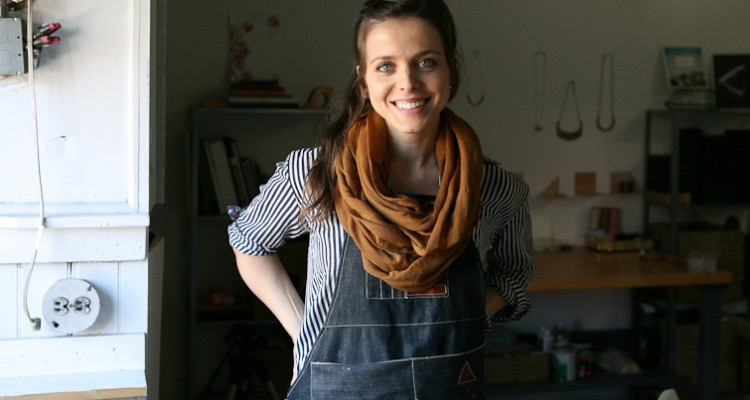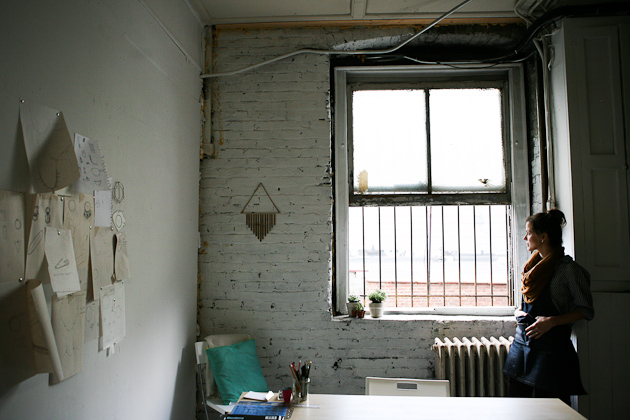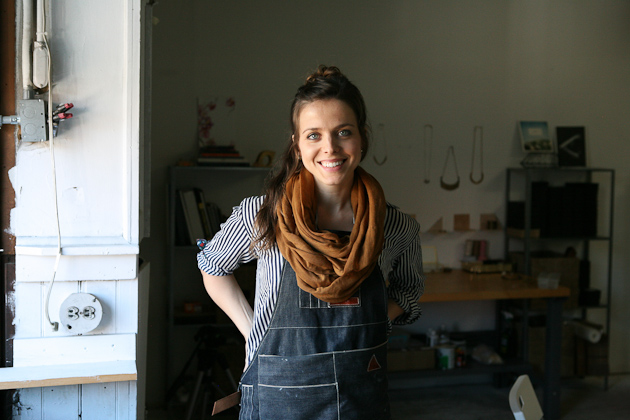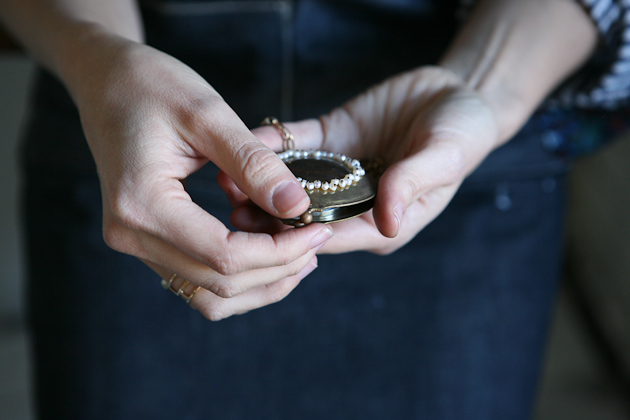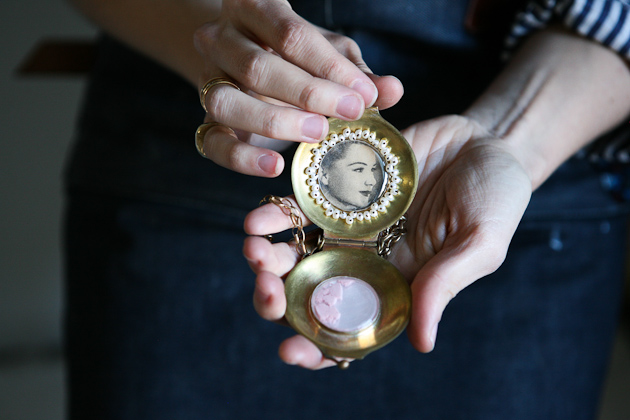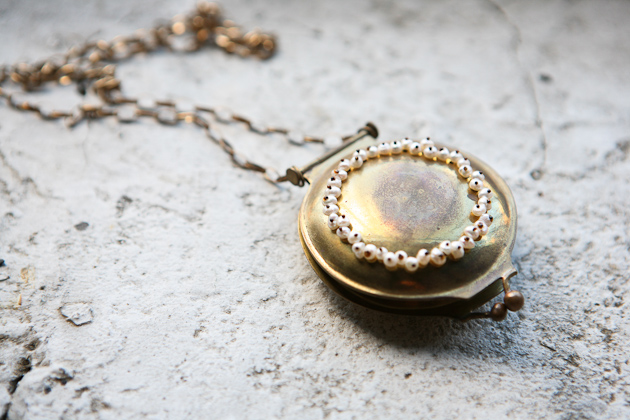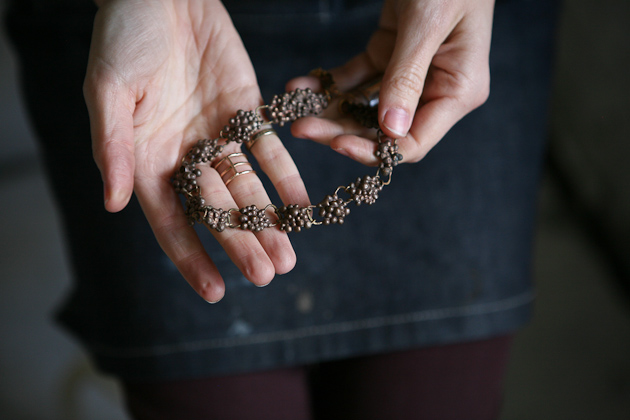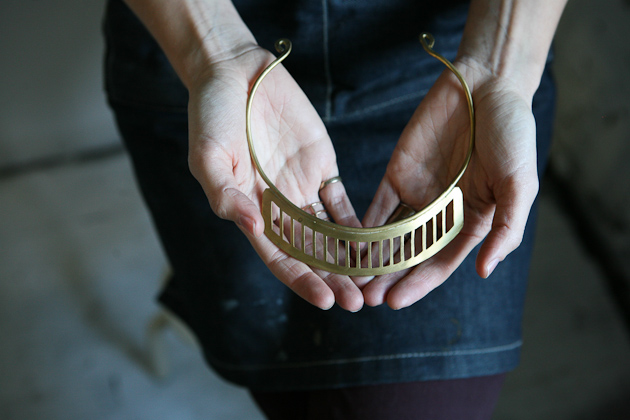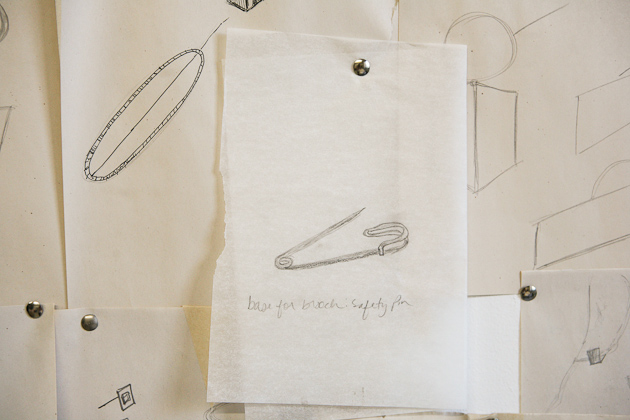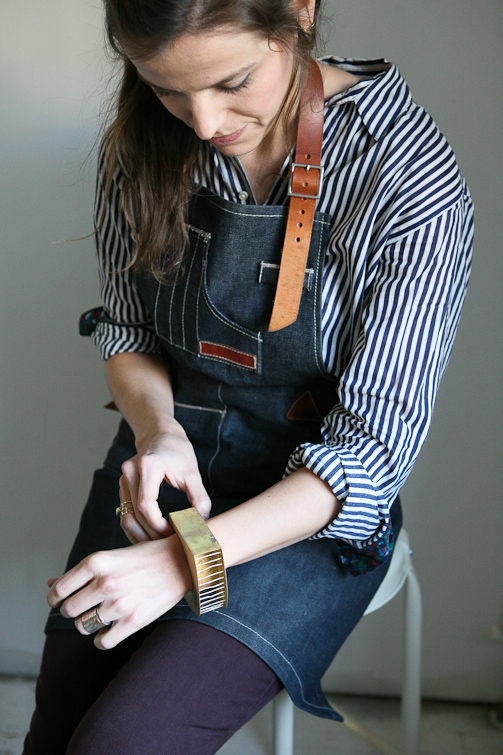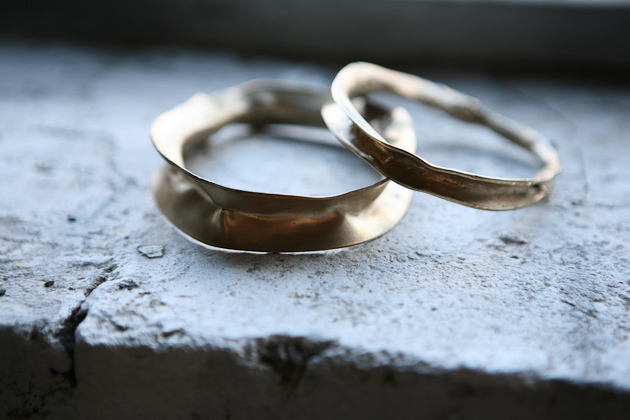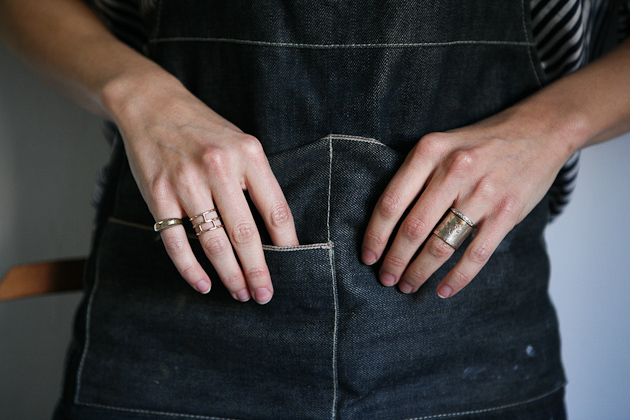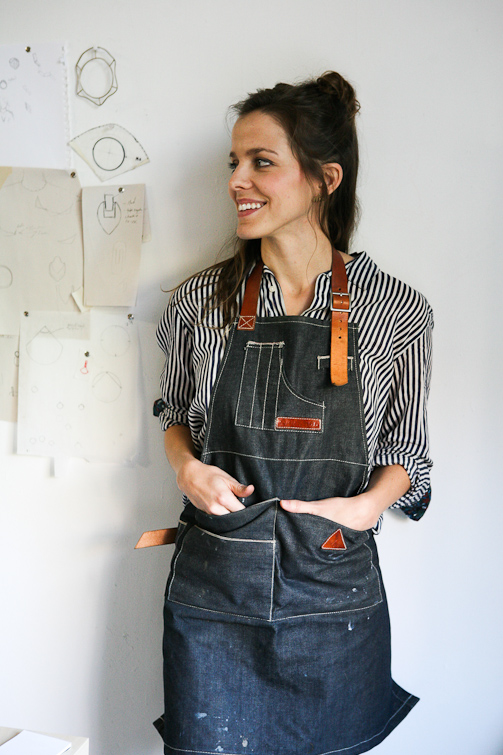On a crisp and sunny October morning, I make my way from Manhattan to Olivia Terrell’s new studio in Williamsburg, Brooklyn. She is finally starting to feel settled after a trans-atlantic move with her husband from Madrid, Spain, where she lived for the past three years, to her new home in New York City. Her studio space is warm and inviting with the glow of brass jewelry on the walls and halfway filled trays of small pieces in progress on her worktable. Sketches of jewelry designs are pinned to one wall illuminated by a soft light filtering through a large opaque window in the corner of the room. As I take notes during our conversation I am most struck by how articulately she recognizes and expresses the various ways her art has been influenced by her roots, her changing surroundings and her everyday life. Originally from Nashville, Tennessee she mentions her work started out with a more organic feel but moving to Spain changed the flavor of her design. Our conversation leaves me with increased curiosity. I am anxious to see how the influence of this new city will manifest itself in her work.
You were interested in building and making things with your hands at a young age. What first sparked your interest in jewelry and metals and what kinds of things did you make growing up?
As far back as I can remember I was always drawn to anything that required working with my hands. There is a home video of me gifting my youngest sister with a necklace made of copy paper and tape on her first birthday. I used to spend hours upon hours arranging flowers (which were actually weeds from the yard) into little bouquets, and when I was in elementary school, I was obsessed with beading and friendship bracelets. I was and still am interested in the source of objects; where a particular object comes from, how it’s made, who made it, etc. I think once I figured out that I could form something that could then be worn or serve a utilitarian purpose, I was sold.
You earned a BFA in jewelry and metals from the University of Georgia. What were the highlights of your time there? What did you plan on doing after graduation?
I was really fortunate to study with some extremely creative individuals and also under really great professors at UGA. A big highlight for me was the relationships built in art school and the ability we had to dialogue about our work. I realize now that I took for granted the ease with which we could critique one another. I definitely miss having the daily companionship and feedback from my classmates. After graduation I needed some time to re-evaluate and figure out what—if anything—i wanted to do with my degree. Many people were going on to work as bench jewelers, but I didn’t feel like that was a good fit for me at that point in my life. I definitely wanted to start my own business, which felt totally crazy. Even just 5 years ago, starting a creative business was not nearly as common as it is today.
Can you tell us a little bit about the pieces you made for your thesis show and the inspiration behind them?
I was in a bit of a creative rut during the time I was supposed to be choosing a direction for the final show of my undergrad degree. I struggled (and still do at times) to try and make something that no one else has done before…to re-create the wheel. I finally realized that there truly is nothing new under the sun, which can seem depressing to a creator-type, but honestly it brought me so much more freedom in the way I approached my work. I think as a young artist, it’s easy to believe that you need to create something one hundred percent new or something utterly profound that no one could possibly understand. I started to be less self-conscious and in turn became more excited about the possibilities for new work. I decided to choose something I knew and that was close to me versus something unknown. I created a body of work around the the culture of the American south and, specifically, what it means to be a female from the south. It was an investigation both objectively, and of my own personal family heritage. I used a quote from one of my favorite authors, Flannery O’Connor, who was a huge inspiration for me, that says, “The Truth does not change according to our ability to stomach it”. I believe there is a lot of value placed on one’s ability to maintain appearances and keep things polished on the surface in the face of conflict or difference, rather than to address an issue for what it is and deal with the pain or awkwardness. All of the pieces I made, though beautiful in appearance, are excessive and precarious to the wearer. I wanted the pieces to ooze sentimentality so I incorporated old watch crystals, time-worn photographs, and pearls. Each piece touches on a different aspect of my investigation. In making the Compact/Locket, I was working through keeping loved ones close to you (as a locket, next to your heart) and yet the simultaneous need to cover up and keep things pretty (as a compact, using blush) despite the intimacy of the relationship.
What led to your move to Madrid? How did your business evolve while you were there? How did living there influence your design?
My husband and I decided to move to Madrid with an organization to aid and support the growth of churches in Spain. I moved with the intent to develop myself as an artist more personally, but didn’t necessarily have big business goals. I wanted to soak in the new culture around me and observe how it affected my artistic process. I quickly realized that I needed a space in which to work, and was very fortunate to find a studio space just minutes from our apartment with two ceramic artists from Italy. it became a space for me to really process all the change I was experiencing. There’s a lot of glitz and glamour to living overseas, especially somewhere like Madrid, but it was definitely difficult at times to feel rooted. My work had always been a bit more organic in style, and I was watching it morph into being more angular and architectural. Early on in my time in Spain, I was experiencing a lot of emotions, good and bad, and everything in my life seemed abstract and loose. Without really realizing it, I was becoming more and more attracted to solid forms, buildings, and things that were seemingly immovable. Some of that could be attributed to the fact that I was now living in a big city, but I also believe I was longing for stability and was really drawn to objects that were static in nature. The Ventana series (cuff bracelet + torc necklace) were both pieces inspired by windows in Mallorca, a Spanish island in the Mediterranean.
You just moved to New York City a few months ago. Why did you choose New York and what do you like about living in Williamsburg so far?
I have always wanted to live in New York City and the timing worked out really well for my husband to go to grad school here and for me to move my business. I’m still really new to Brooklyn, but so far I love working in Williamsburg. I have met so many people doing different and interesting things from all sorts of backgrounds and it just never gets old. At times, the city can feel too fast and like it’s going to eat you alive, but I think in Williamsburg, the rhythm of life is a tiny bit slower.
Can you tell us a little bit about the 3D modeling class you are taking from the Fashion Institute? What ideas do you hope to incorporate into your work?
I’ve taken two classes in a program called Rhino and I hope to continue with that after the Christmas holidays. I don’t know yet exactly what I want to accomplish with this new set of skills, but I love to keep myself fresh and learning always. Having been trained in traditional metal-smithing, it goes against my nature somewhat to design jewelry on a computer, but I am intrigued by the fact that most jobs within the jewelry industry require you to know these design programs now. I guess I am just really curious about it and wondering if there’s a way to use CAD eventually to contribute to my work and enhance my designs.
Tell us a little bit about your process. Where do you look for inspiration? How do you take a piece from conception to finished product? What are your favorite materials to work with?
One of my professors told us in undergrad as we were, I’m sure, complaining about an upcoming project, that one day we were going to wish that someone would give us an assignment to complete…and she was totally right. It can be so hard to confront a blank canvas, so to speak, and it helps to have direction. So that’s what I do; I give myself little projects and tasks to complete to get myself in a headspace where I can create well. I take a day or two to search and collect. During this time I usually stay away from things like Google and Pinterest as I find they really cloud my creativity in the beginning. Don’t get me wrong, Google is normally a dear friend, but I think it’s a healthy practice to not solely rely on the internet. I visit museums, libraries, parks, and more. I people watch. I sketch. I take a lot of photos. I eat good food. I do things that give me energy. I then compile everything from those couple of days and do a ton of quick sketching to get some of my initial ideas out. Then all of those sketches get pinned onto the wall because I need to be able to step back and look at what my brain is doing visually. From those findings and sketches, I create a few more developed drawings of pieces that tend to be larger in size and more conceptual. I then make one or two of these into paper models and eventually into metal. This helps me get out some of the crazy, less approachable jewelry ideas I have and provides me with a springboard for smaller, more ‘wearable’ pieces. Usually, an entire collection I release publicly will have come out of a couple of larger pieces that no one ever sees. I love working with gold because it’s a very forgiving metal and obviously beautiful. I have to say, I love brass for it’s color and cheapness, though it can be difficult to work with.
How does your commissioned work compare to this process? Do your clients come to you with ideas of what they want the piece to look like?
Commission work is a very different process for me. When a client proposes a project, I send them a series of questions to answer so that I can get a better idea of who they are and what it is they are looking for. Often times it’s for wedding-related jewelry so the client is usually confident of what they or their future spouse wants. We go back and forth a few times with sketches that I have come up with until we’ve finalized the design. It’s not my favorite way to work necessarily but it has been fun because you get to know your client really well working on a special project of this nature.
Tell us about your larger metal work. What kind of pieces have you worked on already and what would you like to work on in the future?
I haven’t done a ton of large-scale metalwork, though it’s a dream of mine. I have done a few small sculptures, objects and wall pieces in the past and am interested in working towards designing and making hardware as well as light fixtures. I am really weird and particular about the lighting in a room and so I’ve always been interested in playing with that obsession I have for pleasant lighting…and to combine it with my love of sculpture and metal would be a dream.
Are there any specific artists that inspire you?
Lately i’ve been very inspired by modernist metalsmith Betty Cooke. Her work is minimalistic, but far from boring. She creates incredible pieces with a lot of movement and interesting layers, but with a minimal amount of material. I’ve also been really intrigued by the life and work of Eva Hesse after seeing some pieces at the Whitney.
Do you ever have a hard time letting go of a piece you’ve made?
I sold one of my pieces from my BFA show in college and that was really hard to let go of because I had spent so many hours with it and I felt very attached. With production work, I don’t feel sad to let pieces go, but more fascinated with where the pieces are going. I always feel really honored whenever someone purchases something from me and it’s exciting to think about all the different people in various countries who are wearing my work.
What do you hope those who purchase your jewelry and metal work to walk away with?
I hope people feel like they’re coming away with a quality piece of adornment that has had lots of time and love poured into it. I love the relationship between maker and wearer.
We understand you’re preparing for the Renegade Craft Fair coming up Nov 14 & 15 at the Metropolitan Pavilion in Manhattan. How did you become involved and what can we look forward to seeing there?
Yes! I have known about Renegade for years, but have never been able to participate in the past, so I’m excited to be a part of it this year. I will have a bunch of work from the past 4 collections as well as 5 new pieces that I will release in the next couple of weeks. And maybe a fun deal especially for Renegade shoppers too 🙂
Thank you Olivia, for giving us a peek into your studio space and sharing your process with us. You can view more of Olivia’s work and purchase pieces on her website: www.oliviaterrelljewelry.com. While you’re there make sure to check out her unique wedding ring project here: the wedding ring project. You can also follow her blog www.oliviaterrelljewelry.com/blog/ and instagram account instagram.com/oliviaterrelljewelry/ for future updates.

